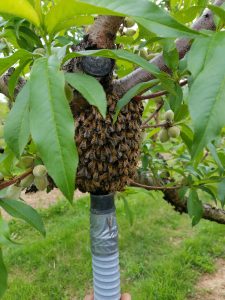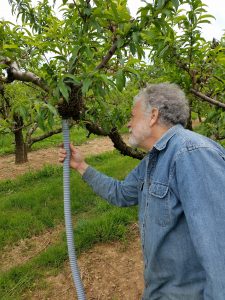Farmers get a lot of bad press about their relationship with bees. Some of that is deserved. But don’t believe everything you read on Facebook.
We rely EXCLUSIVELY on native pollinators to turn pretty flowers into money making fruit every spring. You may be surprised to know that the majority of this work is done by bees and insects other than the honeybee. Bumble bees, sweat bees, Japanese orchard bees… the list goes on. They all live within flying distance of our orchards, and in many cases live within several hundred yards of the orchards.
We manage this in several ways. First, we provide habitat for these bees. Most of our orchards are within sight of woods and creek beds where many native pollinators like to nest. We also frequently provide pollinator friendly cover crops or wildflowers where they can store up energy when our orchards or bushes aren’t blooming. (See the video on cover crops here.)
Secondly, we try really hard not to hurt our pollinators by spraying the wrong chemical at the wrong time. Our climate forces us to manage a multitude of pests by spraying insecticides. In the old days, we would use an insecticide that killed most insects. Today’s integrated pest management approach uses a more targeted method to spray a narrow spectrum insecticide for just the pest that is there.
Here is where the social media knowledge gap lies. Neonicitoid insecticides are systemic in the plant to eliminate insects that are sucking or chewing on the trees. Since bees and predator insects don’t eat our trees, they don’t get killed, even if they visit the orchard after a spray. Moreover, in most commercial orchards, their exposure is very low because we don’t use this kind of systemic chemical until after the bloom is done. So they aren’t getting exposed through the pollen.
If neonics’ were taken off the market, we’d be forced to move back to classes of chemicals that are even more lethal to predators, and it would be a setback for the current balanced approach that we have to managing our insect populations.
Still wonder whether the bees are safe? Here are some pictures of a swarm of honeybees in one of our peach trees. Our friendly neighborhood bee keeper is using a vacuum device to move them into a holding box, and then into a hive. Even though we rely on these guys for our pollination, they stand a better chance of setting up a new colony with his care. But they are welcome to come back and visit!



